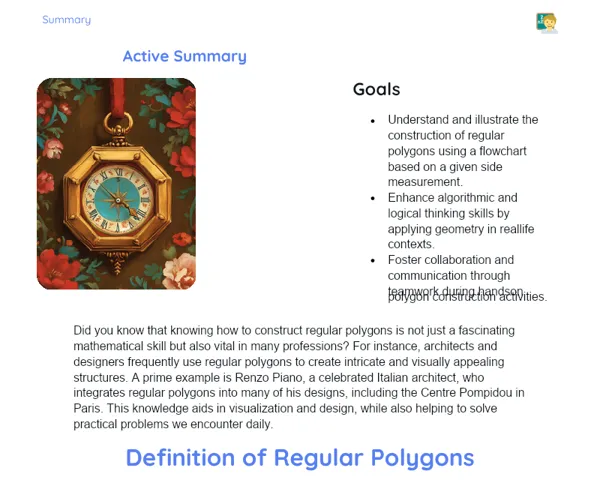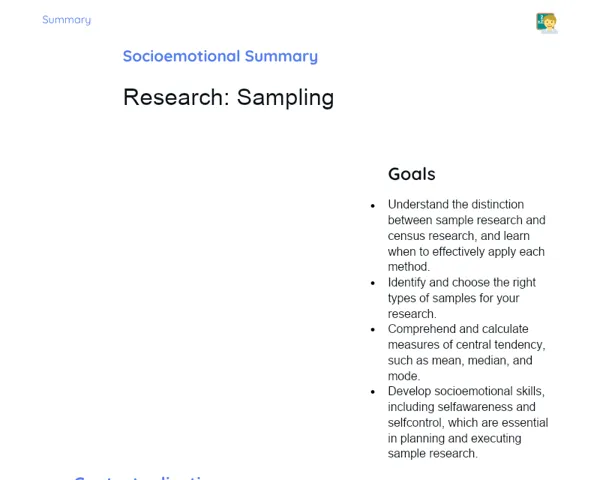Socioemotional Summary Conclusion
Goals
1. Perform multiplication operations by 2, 3, 4, and 5.
2. Solve practical problems that require multiplying numbers by 2, 3, 4, and 5.
Contextualization
Did you know that multiplication plays a crucial role in almost everything we do? 🛒🧮 Whether it's working out the total cost of different items at the kirana store or tallying points in a cricket match, multiplication is everywhere! Mastering how to multiply by 2, 3, 4, and 5 will not only speed up your problem-solving skills but will also make everyday tasks a breeze! Ready to uncover these secrets together? 🌟
Exercising Your Knowledge
Definition of Multiplication
Multiplication is a fundamental mathematical operation that allows us to add a number repeatedly in a quick and efficient manner. For instance, when you multiply 3 by 4, you’re essentially adding 3 four times (3 + 3 + 3 + 3 = 12). Grasping this essential definition is vital for tackling more complicated problems and applying math in daily scenarios.
-
Multiplication as Repeated Addition: In essence, multiplying is just adding a number multiple times, making calculations quicker and more efficient.
-
Importance in Daily Life: From figuring out prices at the bazaar to maintaining score in games, multiplication is an integral part of our everyday activities.
-
Foundation for Advanced Concepts: Multiplication is one of the primary operations that will support your understanding of advanced mathematical concepts in the future.
Commutative Property
The commutative property of multiplication tells us that changing the order of factors doesn't affect the product. For example, 3 x 4 is the same as 4 x 3, both equal to 12. Grasping this property streamlines calculations and aids in solving problems more effectively.
-
Simplification of Calculations: Knowing that it doesn’t matter in which order you multiply can speed up your calculations.
-
Flexibility in Thinking: This understanding fosters a more flexible and creative approach to problem-solving.
-
Basis for Other Concepts: The commutative property serves as a foundation for comprehending other mathematical principles and operations.
Use of Concrete Materials
Utilizing tangible objects, like blocks or marbles, greatly aids in visualizing multiplication. This hands-on approach makes the learning process more concrete and helps students grasp the concept of multiplication through manipulation and counting.
-
Practical Visualization: Seeing and handling physical objects helps in better understanding how multiplication functions in real-life scenarios.
-
Facilitation of Understanding: Working with concrete materials simplifies the concept of multiplication, making it more accessible for many students.
-
Engagement and Interactivity: Employing tangible materials enriches class interactions and makes the learning experience enjoyable for everyone.
Key Terms
-
Multiplication: A mathematical operation that involves adding a number to itself multiple times.
-
Commutative Property: A characteristic of multiplication where the order of factors does not alter the product.
-
Concrete Visualization: A teaching method involving physical objects to aid in understanding abstract concepts.
For Reflection
-
How did you feel while solving multiplications using concrete materials? Did it enhance your understanding of the concept?
-
What emotions did you experience upon realizing that the order of factors doesn’t change the multiplication result? How does this property ease problem-solving?
-
Think about a situation in your daily life where multiplication comes into play. How do you feel when applying this skill in real-world scenarios?
Important Conclusions
-
Multiplication is a key mathematical operation that simplifies various everyday tasks, such as budgeting for shopping and scoring in games.
-
Understanding the commutative property helps in addressing problems with greater efficiency.
-
Incorporating concrete materials, like blocks or marbles, makes understanding and visualizing multiplication a much more enjoyable process.
Impacts on Society
Today, multiplication holds substantial significance in society, from education to day-to-day activities. In education, mastering multiplication is an essential skill that every student should develop before advancing to more complex mathematics. In everyday life, we use multiplication for tasks like determining the total cost of items in a grocery store, measuring ingredients in cooking, and fairly distributing resources.
Moreover, grasping multiplication also has an emotional influence on students. As they learn and excel in this skill, they build confidence in their mathematical abilities, which in turn boosts their self-esteem and motivation to take on new challenges. Such confidence is vital not only for academic prowess but also for future personal and professional growth, as math skills are highly valued across various careers and life pursuits.
Dealing with Emotions
To manage your emotions while studying multiplication, take some time at home for self-reflection. Firstly, identify the emotions you felt during your learning – joy when you grasped a concept, frustration when you faced a challenge. Acknowledge what triggered these feelings and how they affect your learning experience. Then, clearly articulate these emotions: 'I feel frustrated because I made an error,' 'I feel pleased because I succeeded.' It's crucial to express your feelings in a healthy manner, perhaps by chatting with a friend or jotting down your thoughts in a journal. Lastly, regulate your emotions by finding coping strategies - take a deep breath, step away for a bit, or review the material calmly. This will help you maintain emotional balance while learning and applying multiplication.
Study Tips
-
Practice regularly: Dedicate time every day to practice multiplication, beginning with smaller numbers and progressively moving to larger ones.
-
Use games and apps: Look for educational games and apps that make learning multiplication interactive and fun.
-
Make connections to daily life: Apply multiplication to real-life situations, like calculating the total bill while shopping or splitting items evenly among friends.



